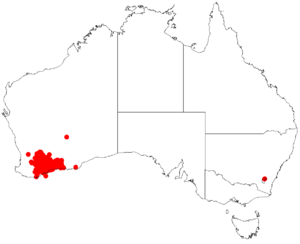Burngup mallee facts for kids
Quick facts for kids Burngup mallee |
|
|---|---|
| Scientific classification | |
| Genus: |
Eucalyptus
|
| Species: |
sporadica
|
 |
|
| Occurrence data from Australasian Virtual Herbarium | |
The Burngup mallee, also known as Eucalyptus sporadica, is a special type of tree or shrub. It's called a "mallee" because it usually has many stems growing from a woody base. This plant is found only in the southwest part of Western Australia. It has smooth bark, long, thin adult leaves, and yellowish flowers that grow in groups. Its fruit looks like a small, woody cone that points downwards.
Contents
What the Burngup Mallee Looks Like
The Burngup mallee is a type of plant that usually grows up to 4 meters (about 13 feet) tall. It has a special woody swelling at its base called a lignotuber. This helps the plant regrow after a fire or damage.
Its bark is smooth and can be many colors. It might be red-brown, grey, greenish grey, or even silvery white. Sometimes, it has a small patch of rough bark near the bottom.
Young plants and new shoots have light green or bluish-green leaves. These leaves are shaped like an egg, a spear, or an oval. They are about 3.5 to 7.5 centimeters (1.4 to 3 inches) long and 1.5 to 3 centimeters (0.6 to 1.2 inches) wide. They have a small stem called a petiole.
Adult leaves are shiny green on both sides. They are shaped like a spear or are slightly curved. These leaves are usually 5 to 10 centimeters (2 to 4 inches) long and 0.8 to 1.8 centimeters (0.3 to 0.7 inches) wide. Their petioles are 0.7 to 2.5 centimeters (0.3 to 1 inch) long.
The flowers grow in groups of seven. They are found where the leaves meet the stem, which is called a leaf axil. Each group of flowers hangs down on a flat stem called a peduncle, which is 1 to 4 centimeters (0.4 to 1.6 inches) long. Each individual flower bud sits on a tiny stem called a pedicel, about 1 to 2 millimeters long.
When the flower buds are ready, they look like a long, uneven spindle shape. They are 1.3 to 2.8 centimeters (0.5 to 1.1 inches) long and 0.3 to 0.7 centimeters (0.1 to 0.3 inches) wide. Each bud has a horn-shaped cap called an operculum. This cap is two or three times longer than the base of the flower, which is called the floral cup.
The Burngup mallee flowers from March or June to October or December. Its flowers are usually lemon yellow to greenish yellow. After flowering, the plant produces woody fruits. These fruits hang downwards and are shaped like a cone or cylinder. They are 0.6 to 1.5 centimeters (0.2 to 0.6 inches) long and 0.7 to 1 centimeter (0.3 to 0.4 inches) wide. When the fruit opens, its seed-releasing parts stick out.
How it Got its Name
The scientific name for the Burngup mallee, Eucalyptus sporadica, was officially given in 2002. Two scientists, Ian Brooker and Stephen Hopper, described it in a science journal called Nuytsia. They studied samples that Brooker collected near a place called Burngup in 1984.
The second part of its scientific name, sporadica, comes from a Latin word. It means "sporadic" or "scattered." This name was chosen because the Burngup mallee is found in many different places, but its trees are spread out and not in one big group.
Where the Burngup Mallee Lives
The Burngup mallee can grow in different types of soil. It likes sand, loam (a mix of sand, silt, and clay), clay, and gravel. You can find it growing on rocky areas like granite outcrops, on hills made of laterite (a type of soil), and in areas where the land suddenly drops off.
This plant is found in the southwest of Western Australia. Its home stretches between Peak Charles, Tarin Rock, and the Fitzgerald River National Park. These areas are part of several different natural regions, including the Avon Wheatbelt, Coolgardie, Esperance Plains, Mallee, and Murchison regions.
Is it in Danger?
The "conservation status" of a plant tells us if it's rare or if there are enough of them. The Western Australian Government's Department of Parks and Wildlife has looked at the Burngup mallee. They have classified it as "not threatened." This means there are currently enough of these plants, and they are not at risk of disappearing.

